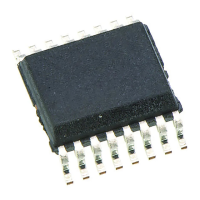RL78/G10 CHAPTER 9 WATCHDOG TIMER
R01UH0384EJ0311 Rev. 3.11 238
Dec 22, 2016
9.4 Operation of Watchdog Timer
9.4.1 Controlling operation of watchdog timer
<1> When the watchdog timer is used, its operation is specified by the option byte (000C0H).
• Enable counting operation of the watchdog timer by setting bit 4 (WDTON) of the option byte (000C0H) to 1 (the
counter starts operating after a reset release) (for details, see CHAPTER 19).
WDTON Watchdog Timer Counter
0 Counter operation disabled (counting stopped after reset)
1 Counter operation enabled (counting started after reset)
• Set an overflow time by using bits 3 to 1 (WDCS2 to WDCS0) of the option byte (000C0H) (for details, see 9.4.2
and CHAPTER 19).
<2> After a reset release, the watchdog timer starts counting.
<3> By writing “ACH” to the watchdog timer enable register (WDTE) after the watchdog timer starts counting and before
the overflow time set by the option byte, the watchdog timer is cleared and starts counting again.
<4> If the overflow time expires without “ACH” written to the WDTE register, an internal reset signal is generated.
An internal reset signal is generated in the following cases.
• If a 1-bit manipulation instruction is executed on the WDTE register
• If data other than “ACH” is written to the WDTE register
Cautions 1. If the watchdog timer is cleared by writing “ACH” to the WDTE register, the actual overflow time
may become shorter than the overflow time set by the option byte by up to one clock cycle of f
IL.
2. The watchdog timer can be cleared immediately before the count value overflows.
3. The operation of the watchdog timer in the HALT and STOP modes differs as follows depending
on the set value of bit 0 (WDSTBYON) of the option byte (000C0H).
WDSTBYON = 0 : Watchdog timer operation stops.
WDSTBYON = 1 : Watchdog timer operation continues.
If WDSTBYON = 0, the watchdog timer resumes counting after the HALT or STOP mode is
released. At this time, the counter is cleared to 0 and counting starts.
When operating with the X1 oscillation clock
Note
after releasing the STOP mode, the CPU starts
operating after the oscillation stabilization time has elapsed.
Therefore, if the period between the STOP mode release and the watchdog timer overflow is short,
an overflow occurs during the oscillation stabilization time, causing a reset.
Consequently, set the overflow time in consideration of the oscillation stabilization time when
operating with the X1 clock and when the watchdog timer is to be cleared after the STOP mode
release by an interval interrupt.
Note 16-pin products only.

